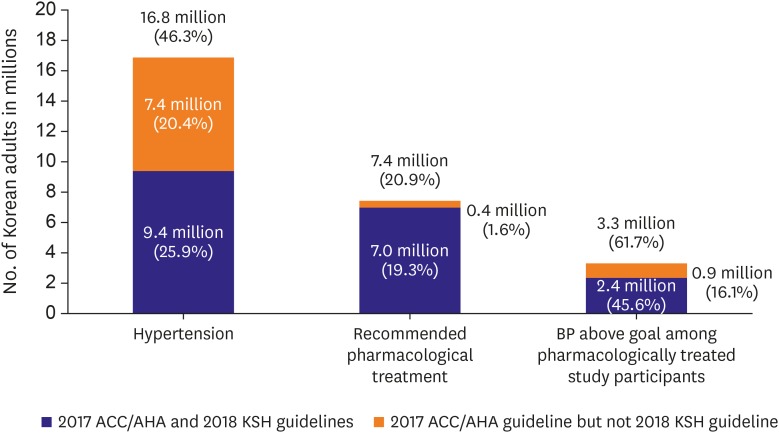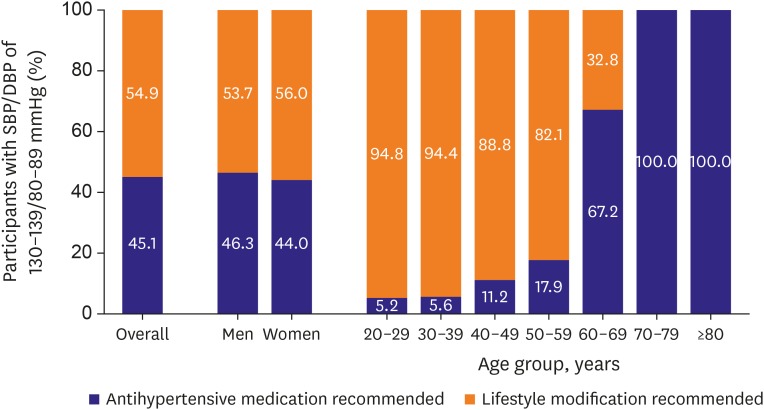Korean Circ J.
2020 Jun;50(6):485-498. 10.4070/kcj.2019.0347.
Comparison and Implication of the Contemporary Blood Pressure Guidelines on Korean Population
- Affiliations
-
- 1Department of Public Health, Yonsei University Graduate School, Seoul, Korea
- 2Department of Preventive Medicine, Yonsei University College of Medicine, Seoul, Korea
- 3Department of Internal Medicine, Yonsei University College of Medicine, Seoul, Korea
- KMID: 2500940
- DOI: http://doi.org/10.4070/kcj.2019.0347
Abstract
- Background and Objectives
This study compared the potential impacts of the 2017 American College of Cardiology/American Heart Association (ACC/AHA) and the 2018 Korean Society of Hypertension (KSH) guidelines on prevalence of hypertension, recommended antihypertensive treatment, and achievement of target blood pressure (BP) in Korean population.
Methods
We analyzed the 2007–2017 Korea National Health and Nutrition Examination Survey data to calculate guideline-specific hypertension prevalence and treatment implications on 59,767 adults aged 20 years or older by sex and age.
Results
The prevalence of hypertension was markedly higher 46.3% by the ACC/AHA guideline due to the lowered BP cutoff than 25.9% by the KSH guideline; the increase was most pronounced in young adults. Yet, there was only a marginal 1.6% increase in the percentage of adults suggested pharmacological approach by the ACC/AHA guideline, but selectively in the older subgroups. Overall, 45.6% of Korean adults treated for hypertension failed to meet BP goal according to the KSH guideline; the underachievement extended to 61.7% of participants according to the ACC/AHA guideline.
Conclusions
The lowered BP threshold, 130/80 mmHg, by the 2017 ACC/AHA guideline, in conjuncture with 10-year risk calculation largely driven by age, would increase pharmacological treatment preferentially in very old individuals, while increasing prevalence and uncontrolled rate mostly in younger subgroups. Adoption of lower BP cutoff to the KSH guideline would require validated cardiovascular disease risk assessment tools accounting for risk distributions specific to Korean population.
Figure
Cited by 2 articles
-
Factors Associated with Awareness, Treatment, and Control Rate of Hypertension among Korean Young Adults Aged 30–49 Years
Yong Woo Jeon, Hyeon Chang Kim
Korean Circ J. 2020;50(12):1077-1091. doi: 10.4070/kcj.2020.0208.Sex- and Age-Specific Trends in Cardiovascular Health in Korea, 2007–2018
So Mi Jemma Cho, Hokyou Lee, Hyeon Chang Kim
Korean Circ J. 2021;51(11):922-935. doi: 10.4070/kcj.2021.0211.
Reference
-
1. GBD 2017 Risk Factor Collaborators. Global, regional, and national comparative risk assessment of 84 behavioural, environmental and occupational, and metabolic risks or clusters of risks for 195 countries and territories, 1990–2017: a systematic analysis for the Global Burden of Disease Study 2017. Lancet. 2018; 392:1923–1994. PMID: 30496105.2. Chobanian AV, Bakris GL, Black HR, et al. Seventh report of the Joint National Committee on Prevention, Detection, Evaluation, and Treatment of High Blood Pressure. Hypertension. 2003; 42:1206–1252. PMID: 14656957.
Article3. Whelton PK, Carey RM, Aronow WS, et al. 2017 ACC/AHA/AAPA/ABC/ACPM/AGS/APhA/ASH/ASPC/NMA/PCNA Guideline for the prevention, detection, evaluation, and management of high blood pressure in adults: a report of the American College of Cardiology/American Heart Association Task Force on Clinical Practice Guidelines. Hypertension. 2018; 71:e13–115. PMID: 29133356.
Article4. Cho SMJ, Lee HK, Kim HC, et al. Differences in prevalence of hypertension subtypes according to the 2018 Korean Society of Hypertension and 2017 American College of Cardiology/American Heart Association guidelines: The Korean National Health and Nutrition Examination Survey, 2007–2017 (KNHANES IV–VII). Clin Hypertens. 2019; 25:26. PMID: 31819805.
Article5. Williamson JD, Supiano MA, Applegate WB, et al. Intensive vs standard blood pressure control and cardiovascular disease outcomes in adults aged ≥75 years: a randomized clinical trial. JAMA. 2016; 315:2673–2682. PMID: 27195814.6. Ettehad D, Emdin CA, Kiran A, et al. Blood pressure lowering for prevention of cardiovascular disease and death: a systematic review and meta-analysis. Lancet. 2016; 387:957–967. PMID: 26724178.
Article7. Kweon S, Kim Y, Jang MJ, et al. Data resource profile: the Korea national Health and Nutrition Examination Survey (KNHANES). Int J Epidemiol. 2014; 43:69–77. PMID: 24585853.
Article8. Chadachan VM, Ye MT, Tay JC, Subramaniam K, Setia S. Understanding short-term blood-pressure-variability phenotypes: from concept to clinical practice. Int J Gen Med. 2018; 11:241–254. PMID: 29950885.
Article9. Kim MK, Ko SH, Kim BY, et al. 2019 Clinical practice guidelines for type 2 diabetes mellitus in Korea. Diabetes Metab J. 2019; 43:398–406. PMID: 31441247.
Article10. Rhee EJ, Kim HC, Kim JH, et al. 2018 Guidelines for the management of dyslipidemia. Korean J Intern Med. 2019; 34:723–771. PMID: 31272142.
Article11. Kidney Disease: Improving Global Outcomes (KDIGO) Hepatitis C Work Group. KDIGO 2018 clinical practice guideline for the prevention, diagnosis, evaluation, and treatment of hepatitis C in chronic kidney disease. Kidney Int Suppl (2011). 2018; 8:91–165. PMID: 30675443.12. Levey AS, Stevens LA, Schmid CH, et al. A new equation to estimate glomerular filtration rate. Ann Intern Med. 2009; 150:604–612. PMID: 19414839.
Article13. Jung KJ, Jang Y, Oh DJ, et al. The ACC/AHA 2013 pooled cohort equations compared to a Korean Risk Prediction Model for atherosclerotic cardiovascular disease. Atherosclerosis. 2015; 242:367–375. PMID: 26255683.
Article14. Goff DC Jr, Lloyd-Jones DM, Bennett G, et al. 2013 ACC/AHA guideline on the assessment of cardiovascular risk: a report of the American college of cardiology/American heart association task force on practice guidelines. Circulation. 2014; 129:S49–73. PMID: 24222018.15. Muntner P, Carey RM, Gidding S, et al. Potential US population impact of the 2017 ACC/AHA high blood pressure guideline. Circulation. 2018; 137:109–118. PMID: 29133599.
Article16. Lewington S, Clarke R, Qizilbash N, Peto R, Collins R. Prospective Studies Collaboration. Age-specific relevance of usual blood pressure to vascular mortality: a meta-analysis of individual data for one million adults in 61 prospective studies. Lancet. 2002; 360:1903–1913. PMID: 12493255.17. Rapsomaniki E, Timmis A, George J, et al. Blood pressure and incidence of twelve cardiovascular diseases: lifetime risks, healthy life-years lost, and age-specific associations in 1·25 million people. Lancet. 2014; 383:1899–1911. PMID: 24881994.
Article18. Böhm M, Schumacher H, Teo KK, et al. Achieved blood pressure and cardiovascular outcomes in high-risk patients: results from ONTARGET and TRANSCEND trials. Lancet. 2017; 389:2226–2237. PMID: 28390695.
Article19. Lee H, Cho SM, Park JH, Park S, Kim HC. 2017 ACC/AHA blood pressure classification and cardiovascular disease in 15 million adults of age 20–94 years. J Clin Med. 2019; 8:1832.
Article20. Yang MH, Kang SY, Lee JA, et al. The effect of lifestyle changes on blood pressure control among hypertensive patients. Korean J Fam Med. 2017; 38:173–180. PMID: 28775806.
Article21. Liu K, Colangelo LA, Daviglus ML, et al. Can antihypertensive treatment restore the risk of cardiovascular disease to ideal levels?: the Coronary Artery Risk Development in Young Adults (CARDIA) Study and the Multi-Ethnic Study of Atherosclerosis (MESA). J Am Heart Assoc. 2015; 4:e002275. PMID: 26391135.
Article22. Chon D, Lee Y, Kim J, Lee KE. The association between frequency of social contact and frailty in older people: Korean Frailty and Aging Cohort Study (KFACS). J Korean Med Sci. 2018; 33:e332. PMID: 30546284.
Article23. Benetos A, Petrovic M, Strandberg T. Hypertension management in older and frail older patients. Circ Res. 2019; 124:1045–1060. PMID: 30920928.
Article24. Peters SAE, Wang X, Lam TH, et al. Clustering of risk factors and the risk of incident cardiovascular disease in Asian and Caucasian populations: results from the Asia Pacific Cohort Studies Collaboration. BMJ Open. 2018; 8:e019335.
Article25. Dorresteijn JA, Kaasenbrood L, Cook NR, et al. How to translate clinical trial results into gain in healthy life expectancy for individual patients. BMJ. 2016; 352:i1548. PMID: 27029390.
Article26. Panza GA, Puhl RM, Taylor BA, Zaleski AL, Livingston J, Pescatello LS. Links between discrimination and cardiovascular health among socially stigmatized groups: a systematic review. PLoS One. 2019; 14:e0217623. PMID: 31181102.
Article
- Full Text Links
- Actions
-
Cited
- CITED
-
- Close
- Share
- Similar articles
-
- The Impact of the SPRINT Trial on Hypertension Guidelines
- Introduction of Recent Hypertension Guidelines
- Blood Pressure Levels in Koreans
- Recent Insights on Blood-Pressure Control Goals and Management for the Elderly
- 2013 Korean Society of Hypertension guidelines for the management of hypertension: part I-epidemiology and diagnosis of hypertension



